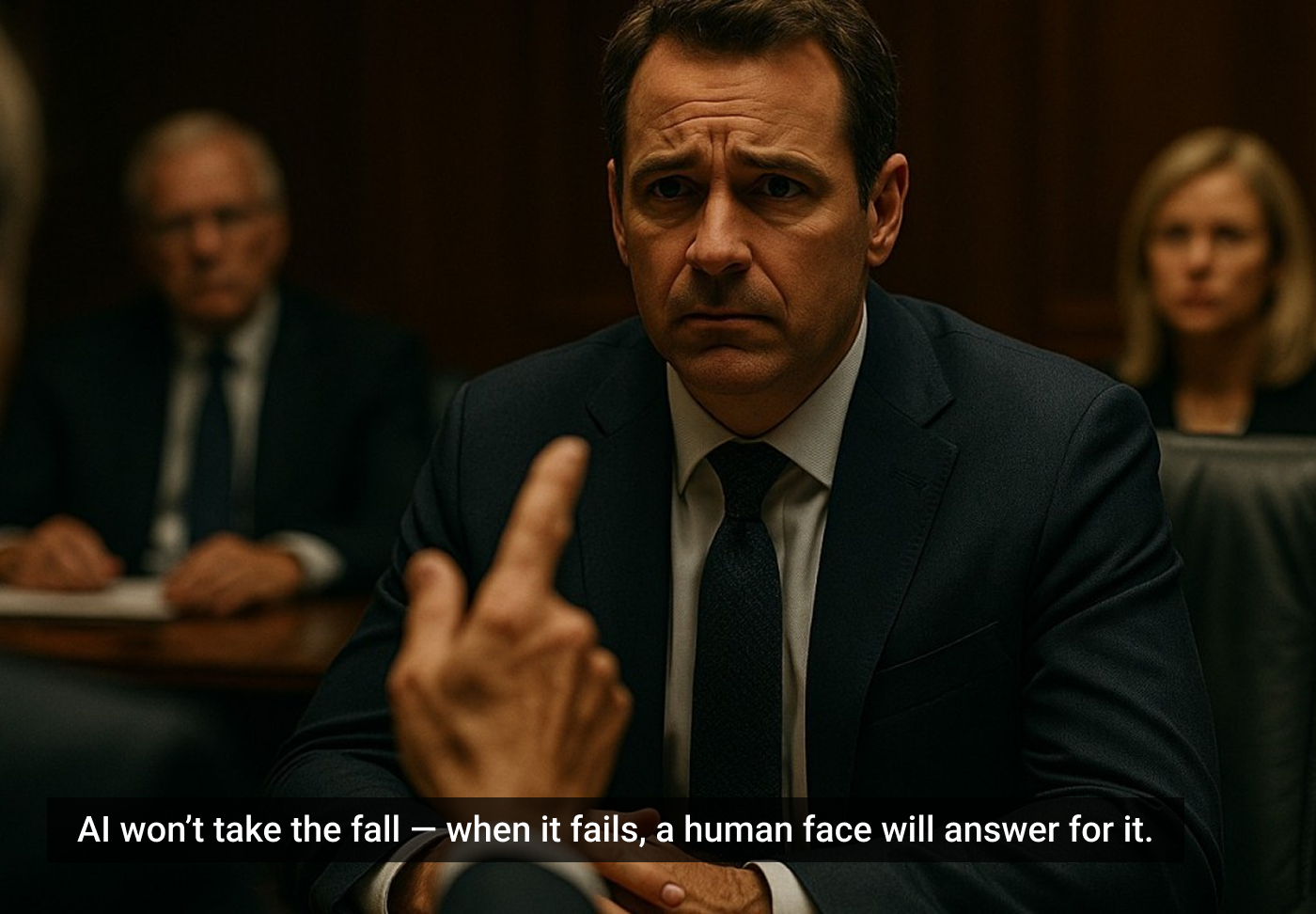Here’s something every CEO knows but won’t say out loud:
When the AI screws up, somebody human is going to pay for it.
And it’s never going to be the algorithm.
The board meeting reality
Picture this scene. You’re in a boardroom. The quarterly numbers are a disaster. The AI-powered marketing campaign targeted the wrong audience. The automated pricing strategy killed margins. The chatbot gave customers incorrect information that triggered a PR nightmare.
The board turns to the executive team and asks one question:
“Who’s responsible?”
Nobody — and I mean nobody — is going to accept “the AI made a mistake” as an answer.
They want a name. A person. Someone accountable.
This is the reality of AI deployment that nobody talks about in the hype articles and vendor demos.
Why human accountability becomes more critical, not less
Most people think AI reduces the need for human responsibility.
The opposite is true.
When AI can execute decisions at unprecedented speed and scale, the quality of human judgment becomes paramount. A bad decision that might have impacted dozens of customers can now impact thousands in minutes.
The multiplier effect of AI doesn’t just amplify results, it amplifies mistakes.
The new job description
In an AI-driven world, the most valuable skill isn’t prompt engineering or machine learning.
It’s defining clear objectives and owning the outcomes.
Every AI system needs a human owner. Not just someone who can operate it, but someone who:
- Defines what success looks like.
- Sets the guardrails and constraints.
- Monitors for unexpected outcomes.
- Takes responsibility when things go sideways.
This isn’t a technical role. It’s a leadership role.
The forensic future
When AI systems fail — and they will — the investigation won’t focus on the algorithm.
It’ll focus on the human who defined the objective.
“Why did the AI approve that high-risk loan?” “Because Sarah set the criteria and authorized the decision framework.”
“Why did the system recommend the wrong product to premium customers?” “Because Mike’s targeting parameters didn’t account for customer lifetime value.”
This isn’t about blame. It’s about clarity. And it’s exactly what executives need to feel confident deploying AI at enterprise scale.
The three levels of AI accountability
- Level 1. Operational Accountability: Who monitors the system day-to-day? Who spots when something’s going wrong? Who pulls the plug when needed?
- Level 2. Strategic Accountability: Who defined the objectives? Who set the success metrics? Who decided what tradeoffs were acceptable?
- Level 3. Executive Accountability: Who authorized the AI deployment? Who’s ultimately responsible for the business impact? Who faces the board when things go wrong?
Every AI initiative needs clear owners at all three levels.
Why this actually accelerates AI adoption
You might think this responsibility framework slows down AI deployment.
It does the opposite.
Executives are willing to move fast when they know exactly who owns what. Clear accountability removes the “what if something goes wrong?” paralysis that kills AI projects.
When leaders know there’s a human owner for every AI decision, they’re comfortable scaling quickly.
The skills that matter now
Want to be indispensable in an AI world? Master these:
- Objective Definition: learn to translate business goals into specific, measurable outcomes. “Improve customer satisfaction” isn’t an objective. “Reduce support ticket response time to under 2 hours while maintaining 95% resolution rate” is.
- Risk Assessment: understand the failure modes. What happens when the AI makes a mistake? How quickly can you detect it? What’s the blast radius?
- Forensic Thinking: when something goes wrong, trace it back to the human decision that created the conditions for failure. Build that feedback loop into your process.
- Clear Communication: if you can’t explain your objectives clearly to a human, you can’t explain them to an AI either.
The uncomfortable questions
Before deploying any AI system, ask:
- Who owns this outcome?
- What happens when it fails?
- How will we know it’s failing?
- Who has the authority to shut it down?
- What’s the escalation path when things go wrong?
If you can’t answer these questions, you’re not ready to deploy.
The leadership opportunity
This shift creates a massive opportunity for the leaders who get it.
While everyone else is chasing the latest AI tools, the smart money is on developing the human systems that make AI deployable at scale.
The companies that figure out AI accountability first will move fastest. They’ll deploy more aggressively because they’ll have confidence in their ability to manage the risks.
(This pairs perfectly with the abundance potential I discussed in my recent piece on how AI amplifies human capability rather than replacing it. The organizations that master both the opportunity and the responsibility will dominate their markets.)
The bottom line
AI doesn’t eliminate the need for human accountability.
It makes it more critical than ever.
The future belongs to leaders who can clearly define what success looks like and own the results — good or bad.
The algorithm executes. Humans are accountable.
Make sure you’re ready for that responsibility.
References:
The article originally appeared on LinkedIn.
Featured image courtesy: Anthony Franco.








